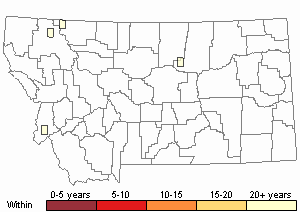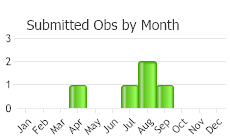View in other NatureServe Network Field Guides
NatureServe
Montana
Utah
Wyoming
Idaho
Wisconsin
British Columbia
South Carolina
Yukon
California
New York
A Ptychostomum Moss - Ptychostomum lonchocaulon
Other Names:
Bryum lonchocaulon, Bryum cirrhatum
General Description
Plants: Acrocarpous (Vitt 1988).Growing in large, loose to crowded patches (FNA 2014) or clumps (Flowers 1973) of erect shoots, green, or green with yellow tones. Stems mostly 1-2 cm tall (FNA 2014), shortly-branched and red (Flowers 1973), with leaves dense at the top of the stem (comose), and generally with rhizoids present (FNA 2014).
Leaves: Green, scarcely larger at the distal end of the stem, curved and twisted when dry, mostly 2-3 mm in length, egg- to lance-shaped, plane or faintly cupped, acuminate; margins rolled tightly back and downward proximally to half or more of the leaf length, the border strong (FNA 2014); costa somewhat yellow or brown, sometimes red proximally, extending well beyond the apex to form an awn, the awn long (sometimes more than half the blade length), spinulose (Flowers 1973) to somewhat smooth (FNA 2014).
Leaf Cells: Middle and upper laminal cells diamond-shaped (FNA 2014), frequently becoming nearly linear in the apex (Flowers 1973), 3-4:1, the walls fine or slightly thicker (firm), as wide as or narrower than the proximal laminal cells; proximal cells quadrangular, 3-4:1; border (limbidium) usually consisting of 3-4 rows of cells that are not yellowish, unistratose (FNA 2014).
Phenology
Fruit ripens in spring to late summer or early fall (FNA 2014).
Diagnostic Characteristics
Bryum lisae var. cuspidatum resembles this species, but has a yellowish, weaker border (usually 2-3 rows of cells rather than 3-4) and faithfully synoicous reproduction (FNA 2014).
Range Comments
North American Range
Canada: BC, AB, and QC; USA: AK, WA s to CA and eastward to MT, WY, CO and NM, also MN and ME (FNA 2014). Known in Montana from Deer Lodge, Flathead, Lake, and Ravalli Counties (Elliott 2016).
Observations in Montana Natural Heritage Program Database
Number of Observations: 5
(Click on the following maps and charts to see full sized version)
Map Help and Descriptions
Relative Density

Recency


 (Observations spanning multiple months or years are excluded from time charts)
(Observations spanning multiple months or years are excluded from time charts)
Habitat
Mostly in shaded areas on moist soil or stones, frequently on somewhat dry mountain sides (Flowers 1973). Elevation: 0-11,380 feet (FNA 2014).
Reproductive Characteristics
Mixed synoicous, polygamous, or producing only antheridia (FNA 2014). Seta reddish (Flowers 1973), mostly 10-20 mm tall. Capsule pear-shaped, 2-4 mm in length, brown, the opening yellow (FNA 2014), the neck somewhat thick and usually not quite half the length of the spore sac region (Flowers 1973); peristome fully developed; exostome teeth yellow below, transparent above; exostome segments with widely ovate openings, the cilia long and transversely ridged (FNA 2014).
No specialized vegetative reproduction present (FNA 2014).
Stewardship Responsibility
References
- Literature Cited AboveLegend:
 View Online Publication
View Online Publication Elliott, J.C. and A.K. Pipp. 2018. A Checklist of Montana Mosses (1880-2018). Updated 3 January, 2020. Montana Natural Heritage Program, Helena, Montana. 73 pp.
Elliott, J.C. and A.K. Pipp. 2018. A Checklist of Montana Mosses (1880-2018). Updated 3 January, 2020. Montana Natural Heritage Program, Helena, Montana. 73 pp. Flora of North America Editorial Committee, eds. 2014. Flora of North America North of Mexico. Volume 28. Bryophytes: Mosses, Part 2. Oxford University Press, Inc., NY. xxi + 702 pp.
Flora of North America Editorial Committee, eds. 2014. Flora of North America North of Mexico. Volume 28. Bryophytes: Mosses, Part 2. Oxford University Press, Inc., NY. xxi + 702 pp. Flowers, S. 1973. Mosses: Utah and the West. Brigham Young University, Provo, Utah. 567 p.
Flowers, S. 1973. Mosses: Utah and the West. Brigham Young University, Provo, Utah. 567 p. Vitt, D. J. Marsh, and R. Bovey. 1988. Mosses, Lichens & Ferns of Northwest North America. Seattle, WA: University of Washington Press. 296 p.
Vitt, D. J. Marsh, and R. Bovey. 1988. Mosses, Lichens & Ferns of Northwest North America. Seattle, WA: University of Washington Press. 296 p.
- Additional ReferencesLegend:
 View Online Publication
View Online Publication
Do you know of a citation we're missing? Elliot, J. C. 1993. Second checklist of Montana mosses. Unpublished report. U.S. Forest Service, Region 1. Missoula, MT. 45 pp.
Elliot, J. C. 1993. Second checklist of Montana mosses. Unpublished report. U.S. Forest Service, Region 1. Missoula, MT. 45 pp. Lawton, E. 1971. Keys for the Identification of the Mosses on the Pacific Northwest. Reprinted from 'Moss Flora of the Pacific Northwest'. Published as Supplement No. 2 of the Journal of the Hattori Botanical Laboratory. Nichinan, Miyazaki, Japan. 66 pp.
Lawton, E. 1971. Keys for the Identification of the Mosses on the Pacific Northwest. Reprinted from 'Moss Flora of the Pacific Northwest'. Published as Supplement No. 2 of the Journal of the Hattori Botanical Laboratory. Nichinan, Miyazaki, Japan. 66 pp. Lawton, E. 1971. Moss Flora of the Pacific Northwest. Hattori Botanical Laboratory. Japan: Yamabuki-cho, Shinjuku-ku, Tokyo. 362 pages plus appendices.
Lawton, E. 1971. Moss Flora of the Pacific Northwest. Hattori Botanical Laboratory. Japan: Yamabuki-cho, Shinjuku-ku, Tokyo. 362 pages plus appendices. Malcolm, B., N. Malcolm, J. Shevock, and D. Norris. 2009. California Mosses. Nelson, New Zealand: Micro-Optics Press. 430 pp.
Malcolm, B., N. Malcolm, J. Shevock, and D. Norris. 2009. California Mosses. Nelson, New Zealand: Micro-Optics Press. 430 pp.
- Web Search Engines for Articles on "A Ptychostomum Moss"





